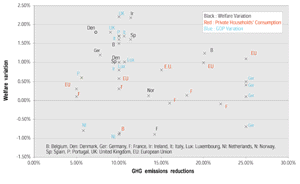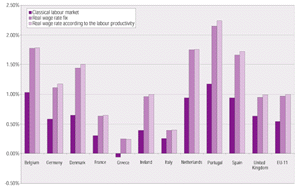8.2.2.1.2 Carbon Taxes and Reducing Payroll Taxes
Figure 8.5 plots the range of the numerical findings
for a wide set of countries. In comparison with the previous results, these
findings are far more optimistic. This confirms the theoretical results that
the gross costs of meeting given abatement targets can be significantly reduced
by using the revenue of carbon taxes to finance cuts in the existing distortionary
taxes, instead of returning the revenues to the economy in a lump-sum fashion.
Only a few studies provide results that allow for a systematic assessment of
the attractiveness of payroll recycling through comparing its welfare implication
with that of lump-sum recycling. For Norway, Håkonsen and Mathiesen (1997)
use a static computable general equilibrium (CGE) model to compare lump-sum
recycling to private households and a reduction in employers’ social security
contributions. Welfare is measured by a combined index of commodity and leisure
consumption. When CO2 emissions are reduced by 20% (i.e., stabilizing
emissions in 2000 at the 1990 level), welfare is reduced by 1% with lump-sum
recycling, but only by 0.3% when tax income is used to reduce social security
contributions. These authors also found ancillary benefits that decrease welfare
losses even further (see Section 8.2.4 below).
|

Figure 8.5: Welfare variation with recycling through payroll
taxes reduction.
|
In this report, it is impossible to identify all the sources
of discrepancies in results across models. Only the differences between results
concerning the USA and European economies are considered. These discrepancies
arise because labour taxes represent one of the most important sources of
distortion in European countries as a result of the pre-existing tax structure
and of the type of labour-market regulation that prevails in these countries.
Note that a systematic outcome of these studies is that an increase in employment
is easier to obtain than an increase in total consumption or social welfare,
which leads some authors to discuss the employment double dividend as distinct
from the efficiency dividend.
While studies conclude that the swap between carbon and payroll taxes reduces
the net burden of climate policies but does not avoid net welfare losses in
the USA (Goulder 1995b; Jorgenson and Wilcoxen, 1995; Shackleton et al.,
1996), a strong double dividend often occurs in Europe. As suggested by theoretical
analyses (Carraro and Soubeyran, 1996), these differences can be explained by
the differences both in taxation systems and in the rigidities of the labour
markets. Capros et al. (1999b) demonstrate (Figure
8.6) that the increase of employment in the EU countries due to payroll
tax reduction is far higher under the assumption of wage rigidities than under
the assumption of a classic flexible labour market. In the same way, Bernard
and Vielle (1999c) do not conclude to a strong double dividend in France, while
Hourcade et al. (2000a) find a modest increase in total consumption of
households (up to 0.2% for carbon taxes up to US$100/tC) because they incorporate
structural unemployment. This is also why the E3ME model (Barker, 1999), econometrically
driven and neo-Keynesian in nature, provides the most optimistic results; they
indeed incorporate the rigidities of the real labour markets. It systematically
finds a net increase in GDP in Europe (from 0.8% to 2.2%), except for the Netherlands,
with a maximum in the UK. The DRI and LINK models, similar in nature to E3M3,
do not find such a gain for the US economy, but a loss of 0.39%.
|

Figure 8.6: Variation in employment.
|
The magnitude of the double dividend for the European countries
is lower in general equilibrium models than in Keynesian models: the welfare
effects in different studies are between –1.35% and 0.57%. Even if these
estimates cover different emission reduction levels for different time periods,
they confirm the attractiveness of payroll recycling. In addition, it is remarkable
that negative figures are found for small economies such as Belgium (Proost
and van Regemorter, 1995) and Denmark (Andersen et al., 1998) in the
situation of a unilateral policy, which confirms the specific interest of
these countries in international coordination.
The magnitude of the second dividend (the net economic benefit of tax recycling)
is not independent of the abatement target. For a given fiscal system, it is
determined by parameters for which sizes vary with the taxation levels (e.g.,
the elasticity of decarbonization in the production sector and in household
consumption, the crowding-out effect between carbon-saving technological change
and non-biased technological change). Unfortunately, only a few studies report
the range of taxes in which the double-dividend hypothesis holds. Hourcade et al. (2000a) found a curve similar to A3 in Figure
8.3; after an optimum around US$100/tC, the double dividend tends to vanish
in the same way. Håkonsen and Mathiesen (1997) found that tax recycling
is actually welfare improving in the range of a 5% to 15% reduction in CO2
emissions. Capros et al. (1999c) are more optimistic in this respect.
They found that the final consumption of households in the EU is increases (about
1%) when the abatement target increases from 20% to 25%. The marginal increase
is, however, lower than when the abatement target increases from 5% to 10%.
8.2.2.1.3 Other Forms of Taxes Reduction
Other forms of tax reductions, such as value-added tax (VAT), capital taxes,
and other indirect taxes have also been studied in addition to recycling via
the national debt and public deficit reductions.
Studies for the USA confirm that the nature of the existing fiscal system matters.
While no study found a strong double dividend for the USA in the case of labour-tax
recycling, the Jorgenson–Wilcoxen model supports this notion when recycling
takes the form of a reduction in capital taxes (Shackleton, 1998). The pre-existing
marginal distortions from taxes on capital are considerably larger than those
from labour taxes. Consequently, according to Jorgenson (1997), if the revenues
were rebated to consumers in the form of reduced taxes on wage and salary incomes,
the cost would be reduced to 0.6%, or by a factor of three compared to the lump-sum
recycling case. But if the taxes were rebated on capital income instead, the
loss would turn into a gain (0.19%). This higher attractiveness of capital taxation
recycling is not found in European countries, with the exception of the Newage
model for Germany (Boehringer, 1997).
|

Figure 8.7: Welfare variation with different recycling policies.
|
The other recycling modes have been scrutinized less systematically,
but yield in general less favourable results than labour- and capital-taxation
recycling. Figure 8.7 synthetises these results. For
Australia, McDougall and Dixon (1996) found that for all the scenarios in
which energy taxes were used to offset reductions in payroll taxes, rises
in GDP and employment were achieved. A decrease in GDP and employment resulted
in the only scenario in which energy taxes were used to reduce the budget
deficit. Fitz Gerald and McCoy (1992) found the same type of result for repayment
of national debt in Ireland (1% GDP loss). These results are also confirmed
in the German case, which is particularly interesting, because several models
(Almon, 1991; Welsch and Hoster, 1995; Conrad and Schmidt, 1997; Boehringer
et al., 1997) simulate the same emission target (–25%) for the
same year (2010) with different types of recycling. They generally conclude
to a strong double dividend, and they find a significantly more pessimistic
variation in welfare (–4.2% against –0.7% in Almon (1991), –0.03%
against +0.1% in Conrad and Schmidt (1996)) when the revenues of the carbon
tax are used to lower public deficit rather than reduce social contribution.
The results are less clear concerning the relevance of recycling via a capital
tax reduction in this country.
For France, Schubert and Beaumais (1998) found, for a carbon tax of US$140/tC,
that these tax recycling schemes are less efficient in terms of welfare than
recycling through payroll tax, because they trigger no mechanism that enhances
employment and general activity. Bernard and Vielle (1999c) confirm this result
for the same country. In a short-run analysis for Sweden, Brännlund and
Gren (1999) found that private income remains almost unchanged if a reduction
in VAT is implemented, because it compensates the regressive income effect of
carbon taxation. Nevertheless, as the income increase in this study is relatively
important compared to the changes in prices, taxes can be raised without altering
consumer behaviour in any considerable way. But this balance may not be preserved
in the case of higher carbon taxes.
There are few studies on mitigation costs and recycling for developing countries,
but China is one exception. Zhang (1997, 1998) analyzed the implications of
two scenarios under which China’s CO2 emissions in 2010 will
be cut by 20% and 30% relative to the baseline. Gross National Product drops
by 1.5% and 2.8%, respectively, in 2010 relative to the baseline, and welfare,
measured in Hicksian equivalent variation (defined in Chapter
7), drops by 1.1% and 1.8%. If part of the revenues raised by carbon taxes
is recycled by equally reducing indirect taxes by 5% and 10%, respectively,
for all sectors the welfare effect is markedly improved, and there may even
be a gain. Garbaccio et al. (1998) report an even more optimistic view
from their simulations on a dynamic CGE model for China. Uniform emissions reductions
of 5%, 10%, and 15% from baseline were studied, and carbon tax revenues recycled
by reducing all other taxes proportionally. In all of the alternative scenarios,
a very small decline in GDP occurs in the first year of the simulation. However,
in each case, GDP is increased in every year thereafter. The result arises through
a shift from consumption to investment brought about indirectly through the
imposition of the carbon tax. Thus, a double dividend may be achieved in China.
|